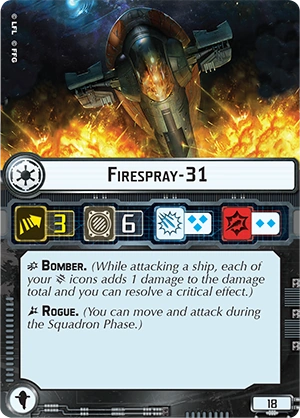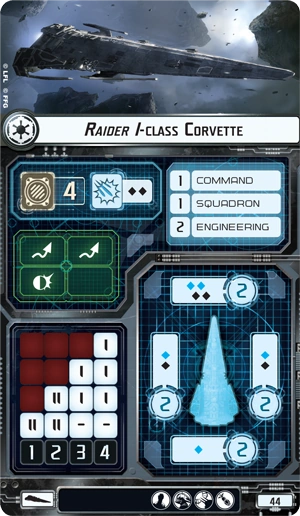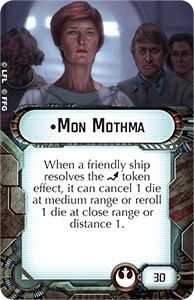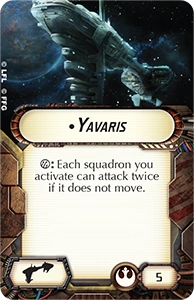In that last post I listed off the advantages of the squadron-free fleet as being Easier to Command, More Activations, More Damage Capacity, and No Wasted Upgrades. Let's start by taking a look at how a squadron-heavy list can minimize or even overcome those advantages.
 Easier to Command - There are two ways to overcome this advantage. The first would be to never issue squadron commands, even in a squadron heavy fleet. With practice this does seem possible, but probably would not be the best use of those squadrons. The new Rogue squadrons provide some possibilities as well, but they are a more expensive option (both in points and the cash to acquire them). I imagine we will see some Rogue heavy fleets in the new Wave 2 setting.
Easier to Command - There are two ways to overcome this advantage. The first would be to never issue squadron commands, even in a squadron heavy fleet. With practice this does seem possible, but probably would not be the best use of those squadrons. The new Rogue squadrons provide some possibilities as well, but they are a more expensive option (both in points and the cash to acquire them). I imagine we will see some Rogue heavy fleets in the new Wave 2 setting. Assuming that you want to take advantage of squadron commands for the greater flexibility it gives your squadrons there are some options. If your admiral is Tarkin or you have another source of tokens, Weapons Liaisons can be a nice fit. The new Wing Commander officer upgrade also gives a great amount of flexibility. With either setup, you can stack your dials with a mix of Navigate or Engineering commands and switch over to Squadron when it makes the most sense. I think the effect of Wing Commander is great and time will tell if he is good enough to justify the cost.

The other thing to consider is how many squadron commands do you really need in the course of a game. I've seen players who set up a carrier and spam the command every round. Usually to their detriment. Often 2-3 well-timed squadron command over the course of the game are enough to make a large impact.
To overcome the squadron-free advantage of having simplified commands you can not use the commands, use and upgrade to add flexibility to the command step, or practice to know when and where to get the most out of those commands without needing to spam them.
More Activations - Wave 2 is going to make this both a larger and smaller problem for any kind of fleet. New ships like the Raider will allow Imperial fleets to up their overall numbers and the 400 point limit will make it easier to have a good ship count AND a good amount of squadrons. Conversely, it will be much easier to build a squadron-free fleet that has an enormous activation count. At Nationals, there was a single 6 CR-90 fleet and he did pretty well. I would expect that at 400 points we will see many fleets that feature a swarm of small ships. This won't just be an issue if you want to play squadron-heavy. This will also be a problem to overcome if you are playing the more expensive large base ships like the ISD or MC-80. So, while it will be easier to bring 4 ships and some squadrons in your fleet, you are still likely to get out activated at some point, especially in a tournament.
 What can you do? Practice. I mean really, that's going to be important. The more I have played, the more I can see the "flow" of the game. The more I can see the flow of the game, the better chance I have of knowing where the extra ships my opponent has might end up.
What can you do? Practice. I mean really, that's going to be important. The more I have played, the more I can see the "flow" of the game. The more I can see the flow of the game, the better chance I have of knowing where the extra ships my opponent has might end up.Go first if you can. One of the main advantages of having extra activations is being able to position some of your fleet after your opponent can no longer respond. If they can then go first, they can set up your ship in deadly traps. Going first will give you the best response to your opponent's late turn movements.
Have some un-activated squadrons in the squadron phase. If you have un-activated squadrons in the squadron phase, especially rogues, they can react to your opponent's extra ship movements and be setup to attack at the start of the next turn in the ship phase.
Stay together. Keep your ships close with your squadrons nearby so you have overlapping firing arcs that can punish his extra ships that try to sneak up on you. Don't let one of your ships get isolated.
 More Damage Capacity - This one may not be fully solved until an actual carrier enters the game. Right now, we have fighting ships that can also coordinate squadrons, but not a real dedicated carrier. I'm wondering when we might see a ship with only blue dice that has a high squadron value.
More Damage Capacity - This one may not be fully solved until an actual carrier enters the game. Right now, we have fighting ships that can also coordinate squadrons, but not a real dedicated carrier. I'm wondering when we might see a ship with only blue dice that has a high squadron value.Until then you can try to improve the resilience of the ships you have. An important bit here is to not over use upgrades. More upgrades means fewer ships and less overall hull. Defensive upgrades seem good, but try to think of the squadrons as your offensive upgrades and don't overspend there. You can use defensive admirals like Mon Mothma or Admiral Motti. If you follow the first point in this article, you can remember to use Engineering commands. Try to make sure the ships in your fleet have a good damage capacity to cost ratio.
Wasted Upgrades - This is an easy one I think. Build your squadrons and carriers with a focus on killing ships. There seem to be far more upgrades that help you kill other squadrons than will help you than will help kill ships. Just because there are more, doesn't mean you should take more. I think that is a trap some folks fall into.
In my experience squadrons are not hard to kill. Some may be annoying, but it is generally not worth throwing a bunch of points at extra squadron killing power. Remember that those points would be wasted against a squadron-free fleet. So, even though it is fun to play with Howlrunner, Soontir Fel, Flight Controllers, Dengar, and a bunch of TIE Interceptors, those squadrons have the same anti-ship potential as an equal number of basic TIE Fighters, which cost a lot less.

The most successful squadron upgrades seem to be Major Rhymer and the Yavaris. This doesn't surprise me as those are both of those upgrades are strongly focused on anti-ship work. Long-Range Comms and Extra Hangar Bays can also help boost anti-ship performance.
Another thing that can work is to only take dedicated anti-ship units like TIE Bombers and Y-Wings. They generally are cheap and tough. You could then upgrade them using Flight Controllers and improve their anti-squadron ability rather than bringing other squadrons to do the job.
This is one you will have to tinker with to find what is right for you, but overall I would rather have too much anti-ship firepower than too much anti-squadron power.
Anyways, hopefully that is a helpful look at how a squadron-heavy fleet can overcome some of the advantages of a squadron-free fleet. Next I'd like to look at the real advantages of bringing squadrons and some of the most points efficient ways of using them.
I really like your articles in general, and I admire your thought-through approach to this discussion (as well as many other perspectives). Squadrons are very much a tool to be used, and also a great part of the Star Wars feel. Keep up the excellent and engaging words!
ReplyDelete/MagnaMusica
Thanks for the encouragement!
ReplyDelete